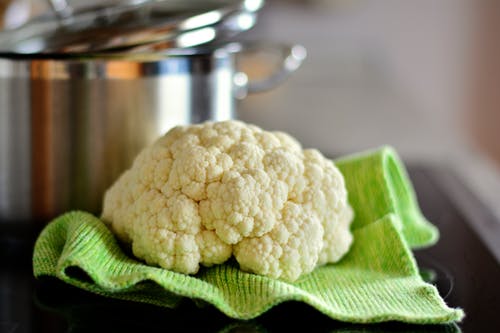By Morgan Crawford a Recent ASU Nutrition Student
I think many people would look at cauliflower in the market or grocery store and pass it by, thinking it’s just another boring vegetable. Even I used to be a skeptic. This plain, white vegetable looks quite uninteresting at first glance, but if you give it a chance, I assure that you will fall in love with is just as I have!
In the early 16th century, cauliflower was first found in Cyprus, where it was then grown in France and Italy. It was in the late 1800s that this crop was brought to the United States, where it was planted in Margaretville, New York. This vegetable is really taken for granted today, seeing as it is grown year-round and is readily available in nearly all grocery stores, but in the early years of its growth and harvest, it was considered a prized crop to many.
Cauliflower belongs to the Cole family, which include broccoli, kale, and cabbage. In German, Cole means cabbage. These mighty crops are also referred to as cruciferous vegetables, which contain sulfur compounds that are known as glucosinolates.
Though the cauliflower we see and the purchase is most commonly white, this vegetable actually has over one hundred varieties with some that are quite colorful. Because cauliflower is in the same family as broccoli, cabbage, and kale, some varieties are a combination, such as Romanesco Broccoli, which looks more like cauliflower but is green and spiky. Another variety known as purple cauliflower gets its color from an antioxidant known as anthocyanins. Lastly, we have an orange variety that contains high levels of vitamin A.

Many of us tend to overlook cauliflower when choosing our vegetables, but it actually has quite a wide range of health benefits. Natural health physician, Dr. Mercola provides the top 8 health benefits of this cruciferous vegetable:
- Cancer-fighting
Sulforaphane is a compound found in cauliflower that has been shown to prevent cancer. It also has an antibacterial component that aids in these processes. Additionally, sulforaphane increases liver function and reduces inflammation.
- Heart health
The same compound, sulforaphane improves overall blood circulation, which leads to better heart health.
- Anti-inflammatory
Even though a small amount of inflammation in the body is actually beneficial for fighting off infection, viruses, and bacteria, chronic inflammation can cause irreversible damage, as is seen with arthritis. Cauliflower has several components that reduce inflammation including indol-3-carbinol, a phytonutrient that is present in cruciferous vegetables.
- Vitamins and minerals
As for vitamins and minerals, this vegetable packs a powerful punch! The most concentrated vitamin found in cauliflower is vitamin C. In just one serving, it has over 75% of the daily recommended amount. Other vitamins and minerals include manganese, potassium, phosphorus, vitamin K, and several B vitamins.
- Brain health
This aspect of health is sometimes overlooked, but it is so vital to every other system in the body. Choline is a type of B vitamin that plays a huge part in the development of the brain. It aids in the creation of DNA and also increases nerve communication.
- Detoxifying
The body has naturally occurring processes of detoxifying, which are enhanced when we consume foods that are high in compounds that promote these processes. Cauliflower contains glucosinolates, which are sulfur compounds that promote the release of enzymes that then detoxify the body.
- Digestive benefits
Dietary fiber is incredibly important for digestive health, but unfortunately, most people don’t consume an adequate amount in their diet. Two cups of cauliflower contain more than 4 grams of dietary fiber, which is around 17% of the daily recommended amount. This makes it an excellent source of fiber that will contribute to an overall healthier digestive system.
- Antioxidants
Free radicals are toxic compounds that are released in the body during the digestive process, breathed in from the air, and even from sunlight interacting with skin cells. Though these compounds are hazardous to our health, there are other substances called antioxidants that combat their negative effects. Antioxidants are capable of neutralizing free radicals, which prevents certain cancers, heart disease, and even slows the process of aging.
With so many options for preparing and cooking cauliflower, this vegetable really proves to be a rather versatile food. To prepare cauliflower, cut away the leaves with a paring knife and separate the head into small florets. From there, you have some options for cooking. My favorite method is to coat the florets in a small amount (1-2 tablespoons) of olive oil, add salt, pepper, and garlic powder, and roast in a 400-degree oven until the edges are crispy- this will take about 25-30 minutes. Another option is to puree the cauliflower. This method of preparation creates a creamy texture that resembles mashed potatoes, but with fewer calories, and significantly higher levels of vitamins and minerals. Follow this easy recipe for garlic mashed cauliflower.
I also found an awesome recipe for sweet and spicy cauliflower. This works well as a side dish or mixed with other vegetables and rice or quinoa for a hearty stir fry. Here is the recipe for sweet and spicy cauliflower!
Ingredients:
4 cups cauliflower florets
2 tablespoons maple syrup
2 tablespoons sriracha
2 tablespoons olive oil
½ tablespoon soy sauce (use tamari if gluten-free)
½ teaspoon black pepper
Instructions:
- Preheat oven to 400 degrees.
- Line baking tray with parchment paper.
- Combine all ingredients in a large mixing bowl and stir until cauliflower is well coated.
- Pour onto baking tray and place in the oven.
- Cook for 30 minutes or until tender.
For more fun articles like this check out the Fill Your Plate Blog. Looking for some fun recipes to try for the family check out our recipe section.

